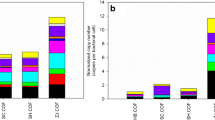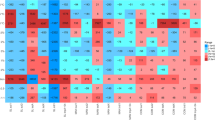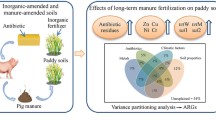Abstract
Land application of manure tends to result in the dissemination of antibiotic resistance in the environment. In this study, the influence of long-term manure application on the enrichment of antibiotic resistance genes (ARGs) and mobile genetic elements (MGEs) in agricultural soils was investigated. All the analyzed eight ARGs (tetA, tetW, tetX, sulI, sulII, ermF, aac(6′)-Ib-cr and blaTEM) and two MGEs (intI1 and Tn916/1545) were detected in both the manured and control soils, with relative abundances ranging from 10−6 to 10−2. Compared with the control soil, the relative abundances of ARGs and MGEs in manured soils were enriched 1.0–18.1 fold and 0.6–69.1 fold, respectively. High-throughput sequencing analysis suggested that at the phylum level, the bacteria carrying intI1 and ermF might be mainly affiliated with Proteobacteria and Bacteroides, respectively. The dominant genera carrying intI1 and ermF could be Pseudomonas and Bacteroides, independent of manure application. Correlation analysis revealed that ARGs had strong links with soil physicochemical properties (TC, TN, and OM), heavy metals (Cu, Zn and Pb) and MGEs, indicating that the profile and spread of ARGs might be driven by the combined impacts of multiple factors. In contrast, soil pH and C/N exhibited no significant relationships with ARGs. Our findings provide evidence that long-term manure application could enhance the prevalence and stimulate the propagation of antibiotic resistance in agricultural soils.

Similar content being viewed by others
References
Agersø Y, Sandvang D (2005). Class 1 integrons and tetracycline resistance genes in Alcaligenes, Arthrobacter, and Pseudomonas spp. isolated from pigsties and manured soil. Applied and Environmental Microbiology, 71(12)): 7941–7947
Aminov R I, Garrigues-Jeanjean N, Mackie R I (2001). Molecular ecology of tetracycline resistance: Development and validation of primers for detection of tetracycline resistance genes encoding ribosomal protection proteins. Applied and Environmental Microbiology, 67(1)): 22–32
Brenciani A, Tiberi E, Bacciaglia A, Petrelli D, Varaldo P E, Giovanetti E (2011). Two distinct genetic elements are responsible for erm(TR)-mediated erythromycin resistance in tetracycline-susceptible and tetracycline-resistant strains of Streptococcus pyogenes. Antimicrobial Agents and Chemotherapy, 55(5)): 2106–2112
Byrne-Bailey K G, Gaze W H, Zhang L, Kay P, Boxall A, Hawkey P M, Wellington E M (2011). Integron prevalence and diversity in manured soil. Applied and Environmental Microbiology, 77(2)): 684–687
Chen J, Yu Z, Michel F C Jr, Wittum T, Morrison M (2007). Development and application of real-time PCR assays for quantification of erm genes conferring resistance to macrolides-lincosamides-streptogramin B in livestock manure and manure management systems. Applied and Environmental Microbiology, 73(14)): 4407–4416
Chen Q, An X, Li H, Su J, Ma Y, Zhu Y G (2016). Long-term field application of sewage sludge increases the abundance of antibiotic resistance genes in soil. Environment International, 92–93: 1–10
Chung W O, Werckenthin C, Schwarz S, Roberts M C (1999). Host range of the ermF rRNA methylase gene in bacteria of human and animal origin. Journal of Antimicrobial Chemotherapy, 43(1)): 5–14
Cui E, Wu Y, Zuo Y, Chen H (2016). Effect of different biochars on antibiotic resistance genes and bacterial community during chicken manure composting. Bioresource Technology, 203): 11–17
Eitel Z, Sóki J, Urbán E, Nagy E (2013). The prevalence of antibiotic resistance genes in Bacteroides fragilis group strains isolated in different European countries. Anaerobe, 21): 43–49
Forsberg K J, Reyes A, Wang B, Selleck E M, Sommer M O, Dantas G (2012). The shared antibiotic resistome of soil bacteria and human pathogens. Science, 337(6098)): 1107–1111
Gao P, Mao D, Luo Y, Wang L, Xu B, Xu L (2012). Occurrence of sulfonamide and tetracycline-resistant bacteria and resistance genes in aquaculture environment. Water Research, 46(7)): 2355–2364
Gillings M R, Gaze W H, Pruden A, Smalla K, Tiedje J M, Zhu Y G (2015). Using the class 1 integron-integrase gene as a proxy for anthropogenic pollution. ISME Journal, 9(6)): 1269–1279
Guo A, Gu J, Wang X, Zhang R, Yin Y, Sun W, Tuo X, Zhang L (2017). Effects of superabsorbent polymers on the abundances of antibiotic resistance genes, mobile genetic elements, and the bacterial community during swine manure composting. Bioresource Technology, 244(Pt 1)): Pt 1
Guo T, Lou C, Zhai W, Tang X, Hashmi M Z, Murtaza R, Li Y, Liu X, Xu J (2018). Increased occurrence of heavy metals, antibiotics and resistance genes in surface soil after long-term application ofmanure. Science of the Total Environment, 635): 995–1003
Hardwick S A, Stokes H W, Findlay S, Taylor M, Gillings M R (2008). Quantification of class 1 integron abundance in natural environments using real-time quantitative PCR. FEMS Microbiology Letters, 278(2)): 207–212
Heuer H, Schmitt H, Smalla K (2011). Antibiotic resistance gene spread due to manure application on agricultural fields. Current Opinion in Microbiology, 14(3)): 236–243
Hvistendahl M (2012). China takes aim at rampant antibiotic resistance. Science, 336(6083): 795
Ji X, Shen Q, Liu F, Ma J, Xu G, Wang Y, Wu M (2012). Antibiotic resistance gene abundances associated with antibiotics and heavy metals in animal manures and agricultural soils adjacent to feedlots in Shanghai, China. Journal of Hazardous Materials, 235–236(20): 178–185
Johnsen B O, Handal N, Meisal R, Bjørnholt J V, Gaustad P, Leegaard T M (2017). erm gene distribution among Norwegian Bacteroides isolates and evaluation of phenotypic tests to detect inducible clindamycin resistance in Bacteroides species. Anaerobe, 47): 226–232
Liu P, Jia S, He X, Zhang X, Ye L (2017). Different impacts of manure and chemical fertilizers on bacterial community structure and antibiotic resistance genes in arable soils. Chemosphere, 188): 455–464
Lu R K (2000). Analysis Methods of Soil and Agricultural Chemistry. Beijing: Chinese Agriculture and Technology Press (in Chinese)
Luo G, Rensing C, Chen H, Liu M Q, Wang M, Guo S W, Ling N, Shen Q R (2018). Deciphering the associations between soil microbial diversity and ecosystem multifunctionality driven by long-term fertilization management. Functional Ecology, 32(4)): 1103–1116
Negreanu Y, Pasternak Z, Jurkevitch E, Cytryn E (2012). Impact of treated wastewater irrigation on antibiotic resistance in agricultural soils. Environmental Science & Technology, 46(9)): 4800–4808
Ng L K, Martin I, Alfa M, Mulvey M (2001). Multiplex PCR for the detection of tetracycline resistant genes. Molecular and Cellular Probes, 15(4)): 209–215
Nguyen C C, Hugie C N, Kile M L, Navab-Daneshmand T (2019). Association between heavy metals and antibiotic-resistant human pathogens in environmental reservoirs: A review. Frontiers of Environmental Science & Engineering, 13(3): 46
Peng S, Feng Y, Wang Y, Guo X, Chu H, Lin X (2017). Prevalence of antibiotic resistance genes in soils after continually applied with different manure for 30 years. Journal of Hazardous Materials, 340): 16–25
Pruden A, Pei R, Storteboom H, Carlson K H (2006). Antibiotic resistance genes as emerging contaminants: Studies in northern Colorado. Environmental Science & Technology, 40(23)): 7445–7450
Pu C, Liu H, Ding G, Sun Y, Yu X, Chen J, Ren J, Gong X (2018). Impact of direct application of biogas slurry and residue in fields: In situ analysis of antibiotic resistance genes from pig manure to fields. Journal of Hazardous Materials, 344): 441–449
Rosewarne C P, Pettigrove V, Stokes H W, Parsons Y M (2010). Class 1 integrons in benthic bacterial communities: Abundance, association with Tn402-like transposition modules and evidence for coselection with heavy-metal resistance. FEMS Microbiology Ecology, 72(1)): 35–46
Sharma V K, Johnson N, Cizmas L, McDonald T J, Kim H (2016). A review of the influence of treatment strategies on antibiotic resistant bacteria and antibiotic resistance genes. Chemosphere, 150): 702–714
Sharma V K, Yu X, McDonald T J, Jinadatha C, Dionysiou D D, Feng M (2019). Elimination of antibiotic resistance genes and control of horizontal transfer risk by UV-based treatment of drinking water: A mini review. Frontiers of Environmental Science & Engineering, 13(3): 37
Shi J, Yu X, Zhang M, Lu S, Wu W, Wu J, Xu J (2011). Potential risks of copper, zinc, and cadmium pollution due to pig manure application in a soil-rice system under intensive farming: a case study of Nanhu, China. Journal of Environmental Quality, 40(6)): 1695–1704
Suzuki M T, Taylor L T, DeLong E F (2000). Quantitative analysis of small-subunit rRNA genes in mixed microbial populations via 5′-nuclease assays. Applied and Environmental Microbiology, 66(11)): 4605–4614
Udikovic-Kolic N, Wichmann F, Broderick N A, Handelsman J (2014). Bloom of resident antibiotic-resistant bacteria in soil following manure fertilization. Proceedings of the National Academy of Sciences of the United States of America, 111(42)): 15202–15207
Wang F H, Qiao M, Lv Z E, Guo G X, Jia Y, Su Y H, Zhu Y G (2014). Impact of reclaimed water irrigation on antibiotic resistance in public parks, Beijing, China. Environmental Pollution, 184): 247–253
Wang M, Liu P, Xiong W, Zhou Q, Wangxiao J, Zeng Z, Sun Y (2018). Fate of potential indicator antimicrobial resistance genes (ARGs) and bacterial community diversity in simulated manure-soil microcosms. Ecotoxicology and Environmental Safety, 147): 817–823
Wu N, Qiao M, Zhang B, Cheng W D, Zhu Y G (2010). Abundance and diversity of tetracycline resistance genes in soils adjacent to representative swine feedlots in China. Environmental Science & Technology, 44(18)): 6933–6939
Xie W Y, Yuan S T, Xu M G, Yang X P, Shen Q R, Zhang W W, Su J Q, Zhao F J (2018). Long-term effects ofmanure and chemical fertilizers on soil antibiotic resistome. Soil Biology & Biochemistry, 122): 111–119
Xiong W, Sun Y, Ding X, Zhang Y, Zhong X, Liang W, Zeng Z (2015). Responses of plasmid-mediated quinolone resistance genes and bacterial taxa to (fluoro)quinolones-containing manure in arable soil. Chemosphere, 119): 473–478
Xu Y, Yu W, Ma Q, Zhou H (2015). Occurrence of (fluoro)quinolones and (fluoro)quinolone resistance in soil receiving swine manure for 11 years. Science of the Total Environment, 530–531: 191–197
Yang F, Zhang K, Zhi S, Li J, Tian X, Gu Y, Zhou J (2019). High prevalence and dissemination of β-lactamase genes in swine farms in northern China. Science of the Total Environment, 651(Pt 2)): Pt 2
Zhang A N, Li L G, Ma L, Gillings M R, Tiedje J M, Zhang T (2018a). Conserved phylogenetic distribution and limited antibiotic resistance of class 1 integrons revealed by assessing the bacterial genome and plasmid collection. Microbiome, 6(1): 130
Zhang J, Chen M, Sui Q, Tong J, Jiang C, Lu X, Zhang Y, Wei Y (2016). Impacts of addition of natural zeolite or a nitrification inhibitor on antibiotic resistance genes during sludge composting. Water Research, 91): 339–349
Zhang L, Gu J, Wang X, Zhang R, Tuo X, Guo A, Qiu L (2018b). Fate of antibiotic resistance genes and mobile genetic elements during anaerobic co-digestion of Chinese medicinal herbal residues and swine manure. Bioresource Technology, 250: 799–805
Zhang S, Zhang F, Liu X, Wang Y, Zou S, He X (2005). Determination and analysis on main harmful composition in excrement of scale livestock and poultry feedlots. Plant Nutrition and Fertilizing Science, 11(6)): 822–829 (in Chinese)
Zhang X, Wu B, Zhang Y, Zhang T, Yang L, Fang H H P, Ford T, Cheng S (2009). Class 1 integronase gene and tetracycline resistance genes tetA and tetC in different water environments of Jiangsu Province, China. Ecotoxicology (London, England), 18(6)): 652–660
Zhang Y J, Hu H W, Gou M, Wang J T, Chen D, He J Z (2017). Temporal succession of soil antibiotic resistance genes following application of swine, cattle and poultry manures spiked with or without antibiotics. Environmental Pollution, 231(Pt 2)): Pt 2
Zhao Z, Wang J, Han Y, Chen J, Liu G, Lu H, Yan B, Chen S (2017). Nutrients, heavy metals and microbial communities co-driven distribution of antibiotic resistance genes in adjacent environment of mariculture. Environmental Pollution, 220(Pt B)): Pt B
Zhou X, Qiao M, Wang F H, Zhu Y G (2017). Use of commercial organic fertilizer increases the abundance of antibiotic resistance genes and antibiotics in soil. Environmental Science and Pollution Research International, 24(1)): 701–710
Zhu B, Chen Q, Chen S, Zhu Y G (2017). Does organically produced lettuce harbor higher abundance of antibiotic resistance genes than conventionally produced? Environment International, 98: 152–159
Zhu Y G, Johnson T A, Su J Q, Qiao M, Guo G X, Stedtfeld R D, Hashsham S A, Tiedje J M (2013). Diverse and abundant antibiotic resistance genes in Chinese swine farms. Proceedings of the National Academy of Sciences of the United States of America, 110(9)): 3435–3440
Acknowledgements
This study was supported by the National Natural Science Foundation of China (Grant No. 21607114) and Science and Technology Correspondent Project of Tianjin (No. 18JCTPJC55100). We also appreciated the help from Professors Xiaomei Wang and Xiaodong Xie during sample analysis. Thanks to Chunjie Li and Fahui Liang for sample collection.
Author information
Authors and Affiliations
Corresponding author
Additional information
Highlights
• Manure application increased the abundances of ARGs and MGEs in agricultural soils.
• Five classes of ARGs and two MGEs were prevalent in manured and unfertilized soils.
• Genera Pseudomonas and Bacteroidetes might be the dominant hosts of intIl and ermF.
• The abundances of ARGs positively correlated with TC, TN, OM, Cu, Zn, Pb and MGEs.
Electronic Supplementary Material
Rights and permissions
About this article
Cite this article
Wu, N., Zhang, W., Xie, S. et al. Increasing prevalence of antibiotic resistance genes in manured agricultural soils in northern China. Front. Environ. Sci. Eng. 14, 1 (2020). https://doi.org/10.1007/s11783-019-1180-x
Received:
Revised:
Accepted:
Published:
DOI: https://doi.org/10.1007/s11783-019-1180-x




